The Chennakesava Temple of Somanathapura, built during the rule of the Hoysala Dynasty of Karnataka, illustrates the prolific skills of the sculptors of that era. It is a sheer exhibition of Hindu scriptures moulded in lifelike sculptures. For an artist, it is a temple where the creators left behind an art gallery for the generations to come. Even for a layman, it would have been a school to grasp the unwritten mythology through an easy pictorial representation. Historians claim it to be an artwork that led Hoysalas to the zenith of their architectural glory. This ornately chiselled ancient temple of India is located near Mysore and is also accessible from Bangalore by road.
Being a non-functional temple, it opens only at 8:30 am and closes down before the sun sets by 5:30 pm. On any weekend it would be a sea of humans in the temple complex. However, weekdays are quiet and only a handful of tourists come for a visit here. We went on Thursday noon and we were around 10 people on the premise at any given time. We took about two and a half hours to completely understand the stories depicted in each sculpture.
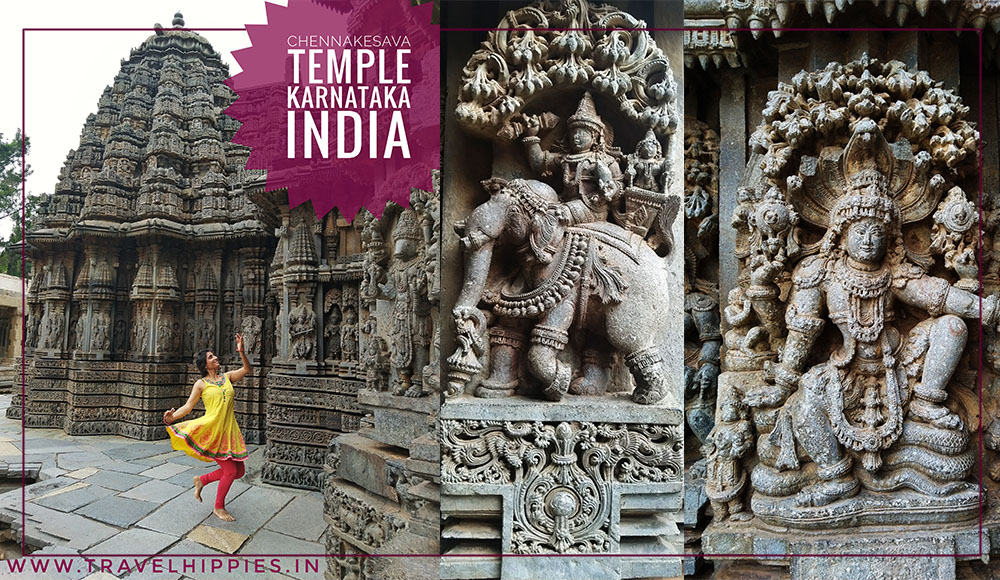
Somanathapura Temple History
The Somnathpur Keshava Temple was built in 13th Century by Somanatha Dandnayaka, a general in the kingdom of Hoysalas under the king Narasimha III. The information about the sculptors, funds and the kings is found on an inscription placed under the Gopuram of the temple. Somanatha created an Agrahara (granting of lands to the Brahmins) and allotted the fund for the construction of the temple. Apart from this Keshava temple, he also built Panchlinga temple, Lakshminarsimha and Yoganarayana Temple in this region which now lay in ruins. This town developed by the general Somanatha was named after him as Somanathapur or Somnathpur.

Somnathpur temple was destroyed during Muslim attacks in the Hoysala kingdoms. The first attack was by Malik Kafur, Alauddin Khilji’s general in 1311 and in 1326 Muhammad Bin Tughlaq destroyed the remaining structures. Some parts of the temples were restored by Vijayanagara Kings and later by Wodeyars of Mysuru. This difference can clearly be seen in the color, carving, and polishing of the stone. The enclosed wall and small Basadis have also been repaired by ASI and are still not in its actual shape or purpose.
The preceding deities of the temple are Keshava, Venugopala and Janadarna. Contrary to the assumption that the Somanathapura temple at Mysore might be a Shiva temple, it is dedicated to three different forms of Krishna, an incarnation of Vishnu. It completely portrays Vaishnavism apart from one or two sculptures of Harihara a combination of Shiva and Vishnu.
If you love architecture and history, Do read about the most ancient temple of Karnatka
How to Reach Somanathapura Keshava Temple from Bangalore
There is no direct bus available from Bangalore to Somanathapura. The Somnathpur Temple near Mysore can be reached by a road trip via Bangalore Maddur Road and then take a diversion towards Talakadu. 7 kilometre ahead of the town of Bennur lays the main temple of Somanathapura. Alternatively, you can take a train to Mysuru and can drive down 34 kilometers to Somanathapura. From Mysore, it is easy to cover Talakadu Panchalingeshwara Temples and Somanathapura Keshava Temple in a day. The nearest airport is located in Mysore.
A Self-guided Photo Walk of Chennakesava Temple, Somanathapura
Follow this guide by starting from the Gopuram or the entrance and then climb the four steps leading to the main shrine. The stories on the wall are sequenced in a clockwise manner. This compels you to begin from your left while facing the main shrine on the star-shaped platform. It is also the temple’s circumambulation path. You can either start with this path first or with the main shrine, the choice is yours as it is a non-functional temple. We started with the circumambulation first and then entered the garbhgriha.
Start at the Broken Mahadwara and Basadis
The entrance or the Mahadwara of this temple, showcasing the typical Hoysala style, is built on a level the same as the main shrine. Mahadwara can be seen as a square mandapa unlike the typical Dravidian temple. This temple is built in Vesara style which a mixture of Nagara (North Indian) and Dravidian Style (South Indian). The small Basadis or temple rooms built encompassing the wall are recently restored.
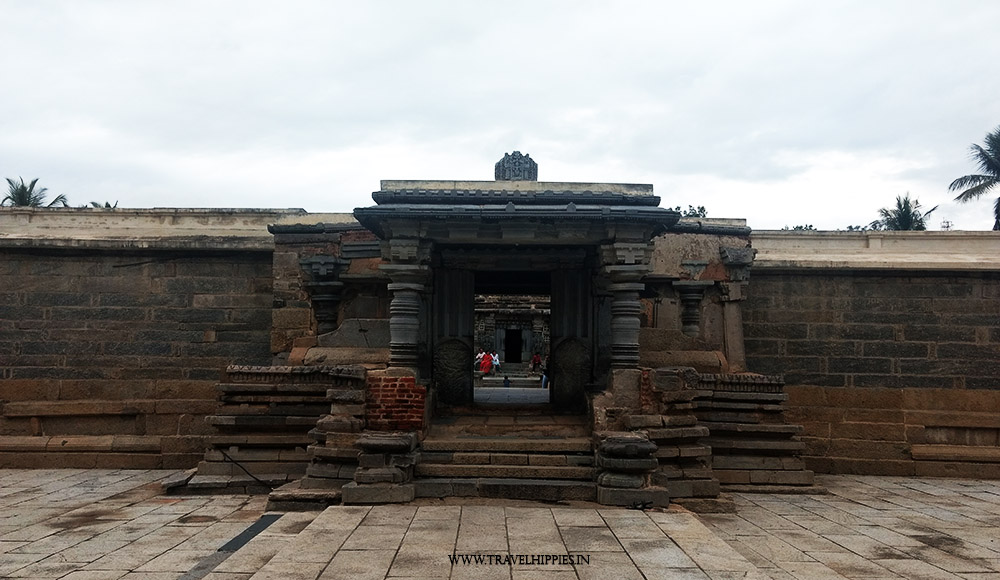
The basadis may have been used to place the idols of local deities, yakshas, Jain Tirthankaras or sages. During the attack by Tughlaqs who first destroyed the main temple in search of gold, these basadis were completely unearthed just to find the gold. In earlier times in the absence of banks, the locals kept their gold safe in the temples under the supervision of the Brahmins. The attackers might be informed of the very fact and thus plundered the shrines.
The tall inscription on the left is written on soapstone or Chalkstone that is soft while it is brought from the quarry but hardens after it is exposed to wind and heat. On the open platform where the basadis aren’t restored, ASI has placed different idols found from the other ruined temples and the Basadis of Somanathapura Temple.
The Dwarpalakas and the Main Shrine
The two Dwarpalakas at the entrance aren’t monoliths, nor are the other huge idols. The parts of idols are fixed together to make a complete idol. The Dwarpalaks Jaya and Vijaya unusually resemble the main deity Keshava. They also have four hands hold different symbolic weapons of Lord Vishnu. Though most of their hands and other parts are now broken, the existing structure tells of its ancient glory. On the opposite side, from the place you entered you can see two kshetrapalas.
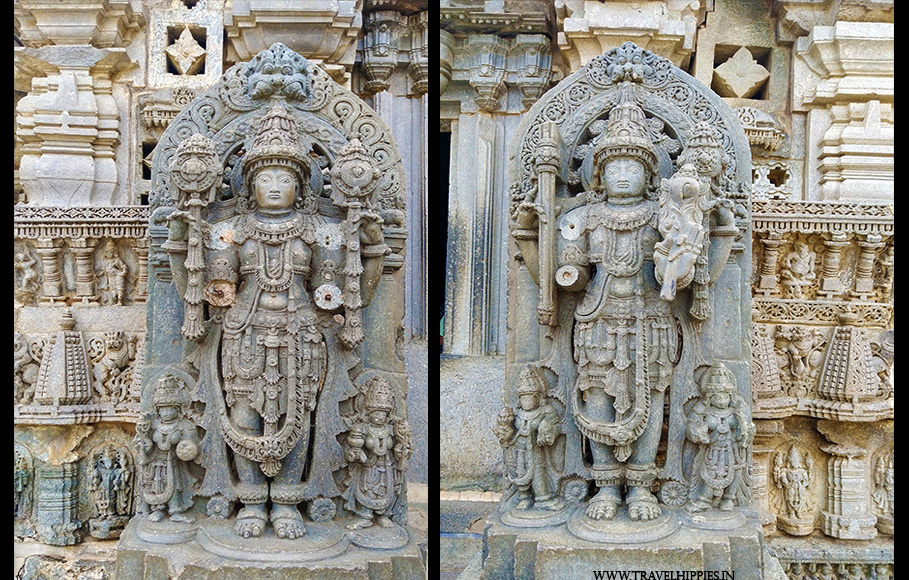
The wall right beside the dwarpalas shows the soldiers marching holding their weapons. This may be a depiction of an army heading for a war or a mere military drill. You can also see the meditating Buddha’s small sculpture.
Decoding the Carving on the Exterior Wall of the Temple
The outer wall of the temple is divided into horizontal bands with each of them depicting an element of religion, culture or nature. The outer wall of the Sabha Mandap contains no major carving of any deity but just the scenes from Ramayana and Kamasutra. Detailed carving can be observed on the walls of the sanctum Sanctorum.

The Elephant Band
At the base is the strongest animal which is also an important part in the army of the kingdom. It also symbolizes the strong base of the Hoysala Kingdom. Apparently, they seem like they are marching for a war or a rehearsal of the same. Further observation would make you realise that not all of them are marching furiously for the war. The playful gestures wherein the elephants are notoriously teasing the other makes this art more animated. None of these elephants looks the same and an overall picture shows an artist’s efforts of bringing stones to life.

‘Ashvapatti’ or the Horse Band
Above the elephants have been staged the horses, another important animal for a strong army. The horse riders seem to be carrying different objects suggests the casual riding by the soldiers, travellers and common men. On the right wall, horses are replaced by camels in some blocks.
Natural Elements

A beautiful design that might have been inspired by the rich flora and fauna of the region repeats itself on this band all around the temple. It includes an imaginary bird surrounded by creepers and flowers.
The Stories of Ramayana, Bhagavad Purana, Vishnu Purana, and Mahabharat
The stories from the Hindu Mythology surrounds this temple like the story pages flipping from all the three books in a sequence. It starts with the Ramayana story of Dasharatha performing Yagya for the heirs and continues till the death of Ravana. Not all details are elaborated but it is enough to understand the main events which mainly occurred in south of India and Srilanka.




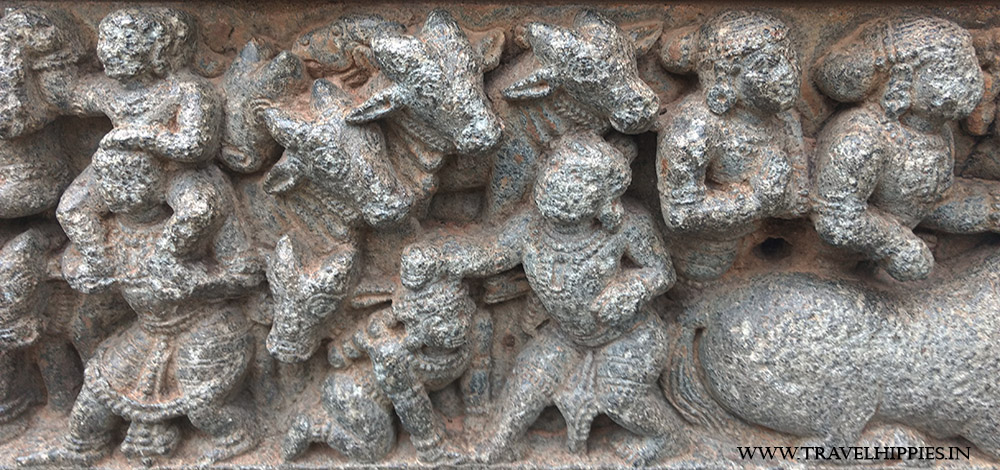
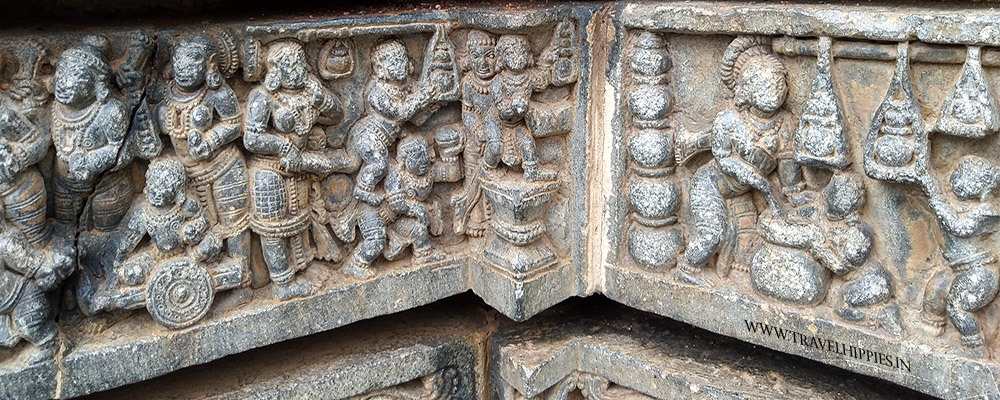

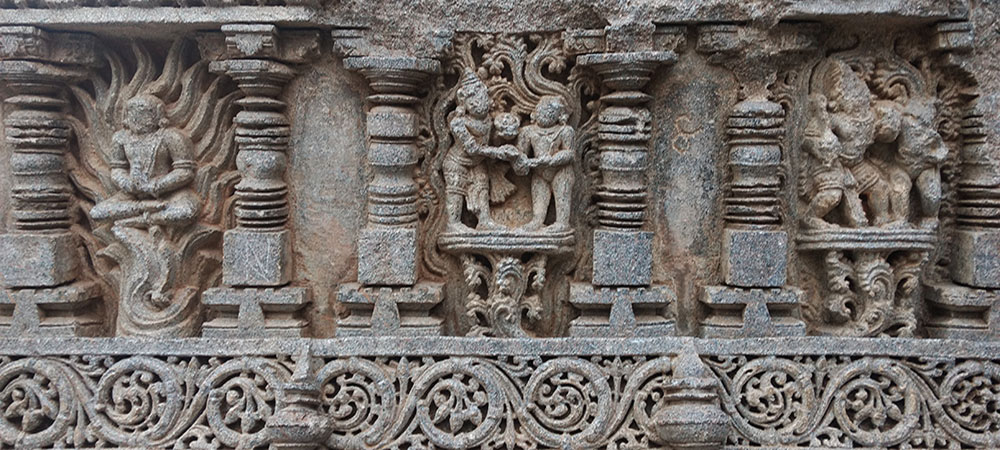
The stories of Bhagavad Purana continues on the backside wall. Some of these figures also shows the indoor sports of Dwand Yuddh or ‘Kushti’ being practised by the students. The natural sceneries and Kushti scenes then takes over the Krishna stories. Krishna stealing the butter, cloths of the gopis and the killing of Putna has also been engraved in detail. In the end, the story of Holika, Prahalad and Hiranyakashyapu paving way to the Narsimha Avatara can be seen.
Makara – The Mythological Creature
This creature called Makara is not an actual crocodile but just an animal having body parts of different animals. This creature has a mouth of a crocodile, body of a pig, feathers of a peacock, monkey’s eyes, cow’s ears, paws of a tiger, and elephant’s trunk. These are also the major animals of the forests surrounding the then empire of Hoysalas. The historians are of the viewpoint that each of these parts denotes a quality of Hoysala Empire and its kings. And here it is:

Crocodile: A set of fierce weapons that don’t spare a culprit/enemy.
Pig: The vastness of the empire that welcomes everything within.
Peacock: The natural beauty with which this empire is blessed.
Monkey: An eye to observe things despite being at the top.
Cow’s ears: Flexible system in which nothing goes unheard.
Tiger: The grip so strong and a blow so fierce
Elephant: Suggesting the strength of the Hoysala kings.
Read the Guides to the Other Temples of Karnataka and Goa
Madhukeshwara Temple of Banavasi, Your Detailed Handy Guide
Shravanbelagola – Unravel the Real Story of The Mighty Bahubali
The Elements of Kamasutra
Unlike the other Krishna temples where Rasleela would have been the main art, the walls of Chennakesava Temple of Somanathapura depict Kamasutra. Only the left wall of the sabha mandap has a few carving which disappears as the series of sculptures of Gods and goddesses start from the outer wall of the first sanctum sanctorum.

Mayura Band

The topmost band consists of the figures of peacocks or Mayura. It was supposedly a favourite bird of Krishna. He also ornamented his crown with a peacock feather.
A Gallery of the Dancing Gods
This band would blow your mind as it looks as unusual as it sounds. Almost all the major deities including the incarnations of Vishnu have been beautifully carved by different sculptors. It is strange to even find a block below each carving bearing the sign of its creator. This shows the contribution of different (approximately 500) sculptors who contributed in the form of these ornate carvings. The main among the contributors were the sculptors named Malitamma, Masalitamma, Bameya, Chowdeya, and Chameya.
Total Big idols here are 194 out of which 164 are Lord Vishnu.
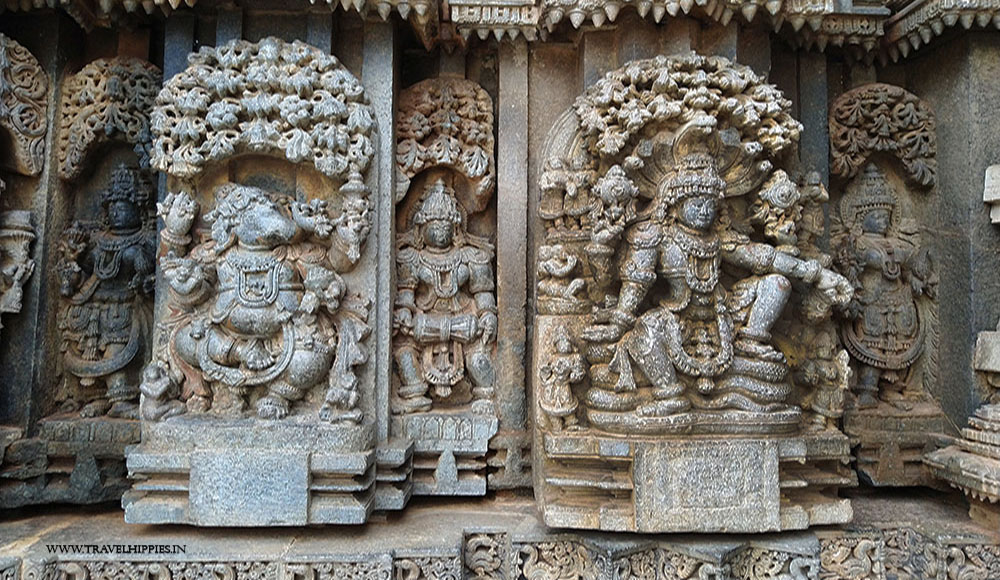

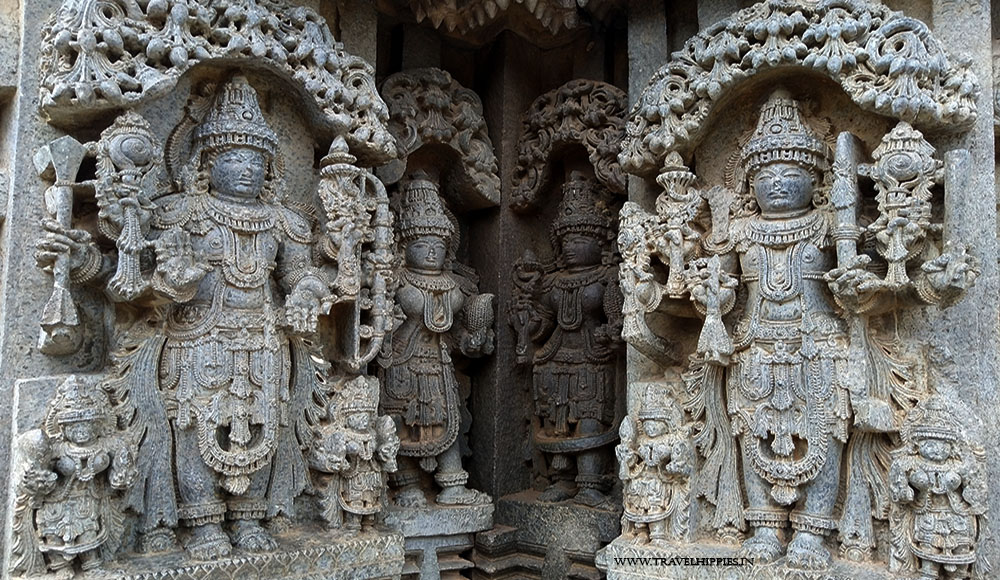

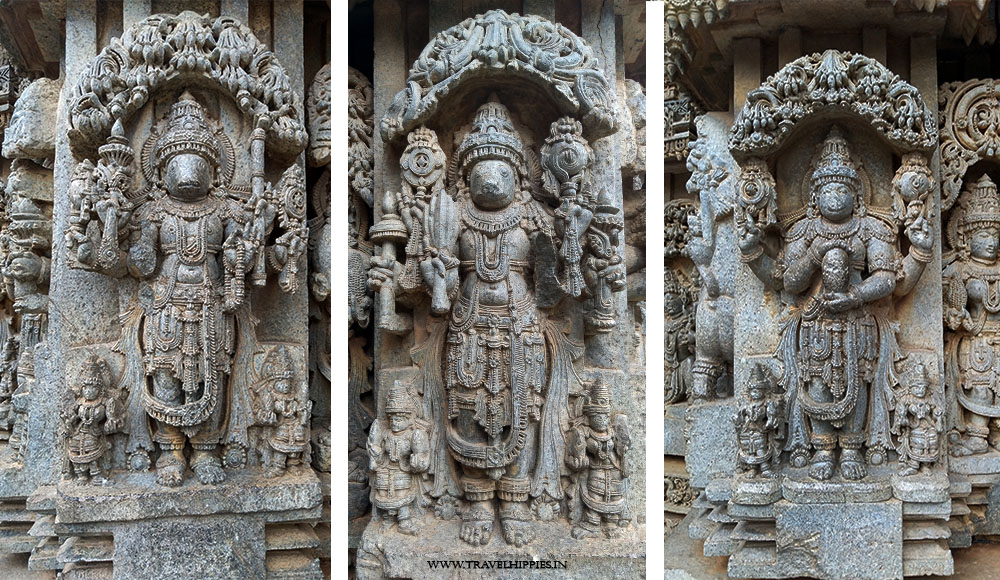



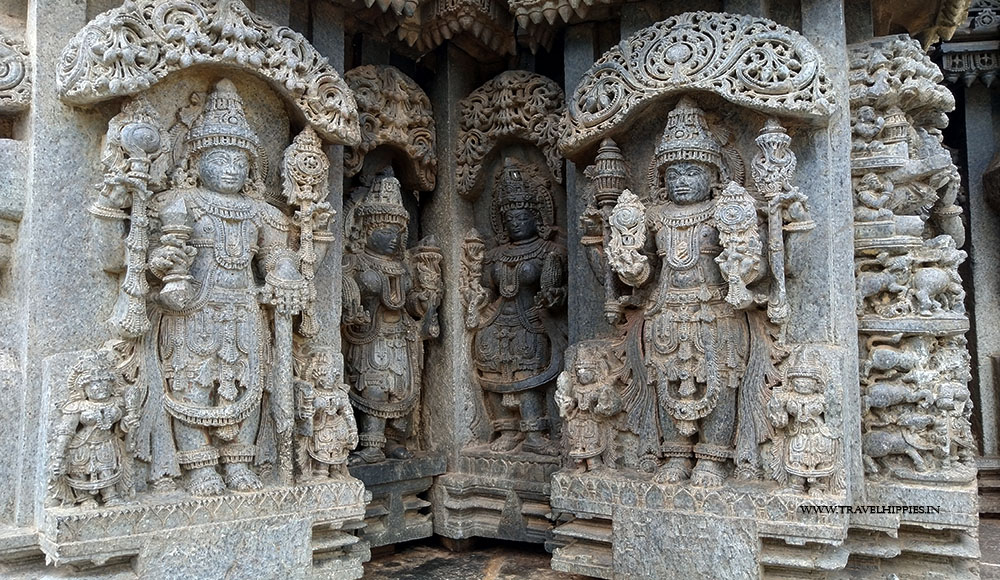


Intricately Carved Vimana
All Vimanas or Shikharas are intricately carved in the vertical bands. The Shikharas end up in an angle matching with each wing of the star-shaped platform. Each Shikhara of a sanctom has 12 angles forming a total of 36 for this Trikutachala Temple. Earlier, they also had an elephant structure filling the gap on each angle(Read a wing of the star) on the platform. As of now, you can observe each angle of the shikhara perfectly in sync with the platform angles. The carvings of the Shikharas mainly include yakshas and celestial figures.
Interior of the Temple
The Navaranga
The huge Sabha Mantap welcomes you upon entering the main shrine. The sturdy pillars support the Mantapa and its inextricably carved ceiling. A combination of a total of nine squares form the huge hall of the temple and is thus called Navranga. Right before entering the garbhgriha, a slightly raised stage gives a glimpse of all the three deities from the same place. This is also a place of dancing which denotes the presence of the Devadasi system.
The Blooming Ceiling
Don’t, just head straightway to the garbhgriha but take a moment to look up as you enter the sabha hall. The entrance square depicts the social life of the bygone era. Musicians, dancers, soldiers, Shiva-Parvati, Vishnu and some courtiers can be seen sitting on the rim as insanely dwarf figures. Different stories can be seen engraved on the domical ceiling. This is the most interestingly carved ceiling squares of all. You can also see a fresh bud popping down the centre of the dome here.
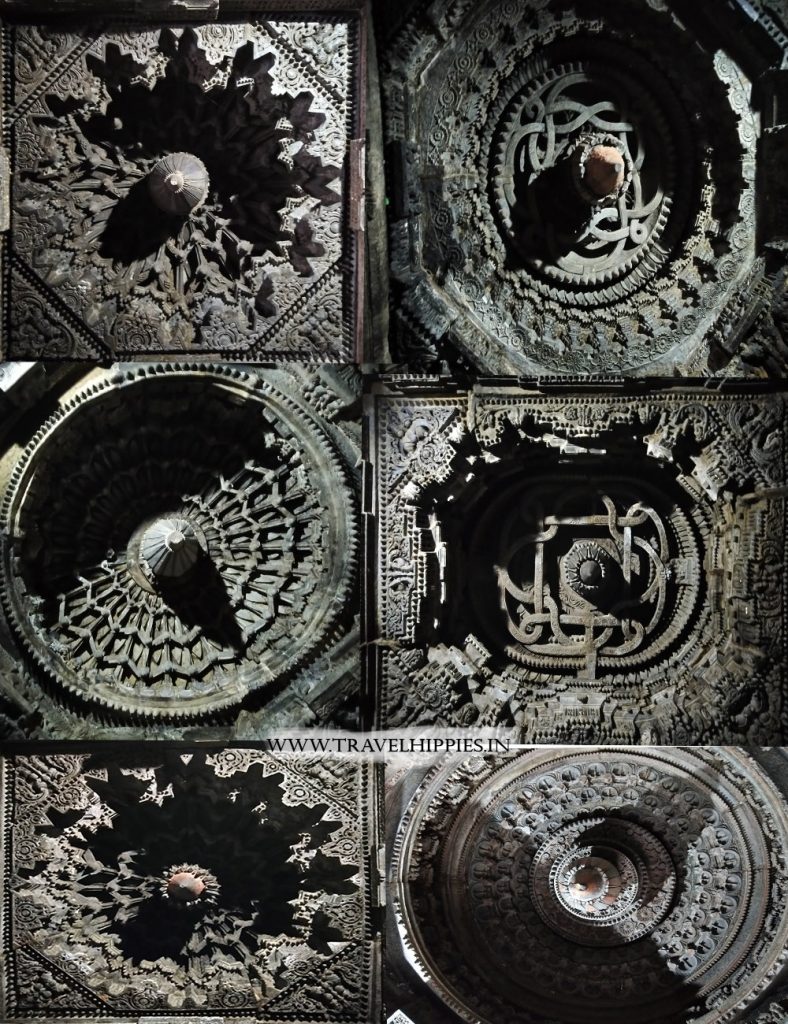
Further as you move in a zigzag manner through each square (again starting from the left), you would see the blooming stages of the lotus. A few of these squared also have a Naagpash Rangoli carving or a jumbled snake carving along with the lotus bud. This may also denote the endless wheel of Karma-Samsara. Finally, as you reach the final square, the completely bloomed lotus flower ceiling can be seen at the top with the beautiful Keshava in front. Lord Janardan is placed on your right and Venugopala on the left.
The Typical Hoysala Pillars

The pillars are the iconic hallmark of Hoysala architecture. Out of the total 16 pillars in the hall 2 are handcrafted with geometric and nature’s design on them. The others are chiselled with the help of animals’ attached with a simple machine. These pillars are a combination of 5 different parts attached together. The bottom square, the chiselled body, lamp holding plate and finally the connector to the ceiling are the main parts of the pillar.
The Tri-shrined Sanctum Sanctorum
This temple has been constructed in Trikutachala order. This means that there is not just one garbhgriha but three for the same deity under different names.
Keshava
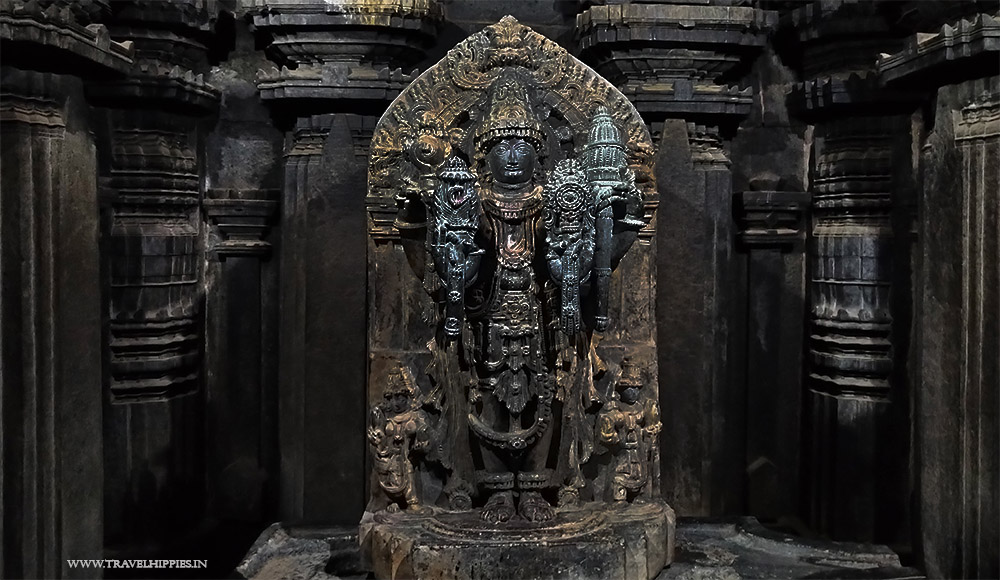
The centre Sanctorum facing the east has an idol of Chennakeshava which means a ‘beautiful Krishna.’ This temple is also named after this deity who is known by one of the many names of Lord Krishna. The masterpiece idol of the temple was first damaged during the Tughlaqi invasion and then was taken away by the British to keep it as a point of attraction in their country. Till date, the idol in the main shrine is just another idol taken off from the temple complex.
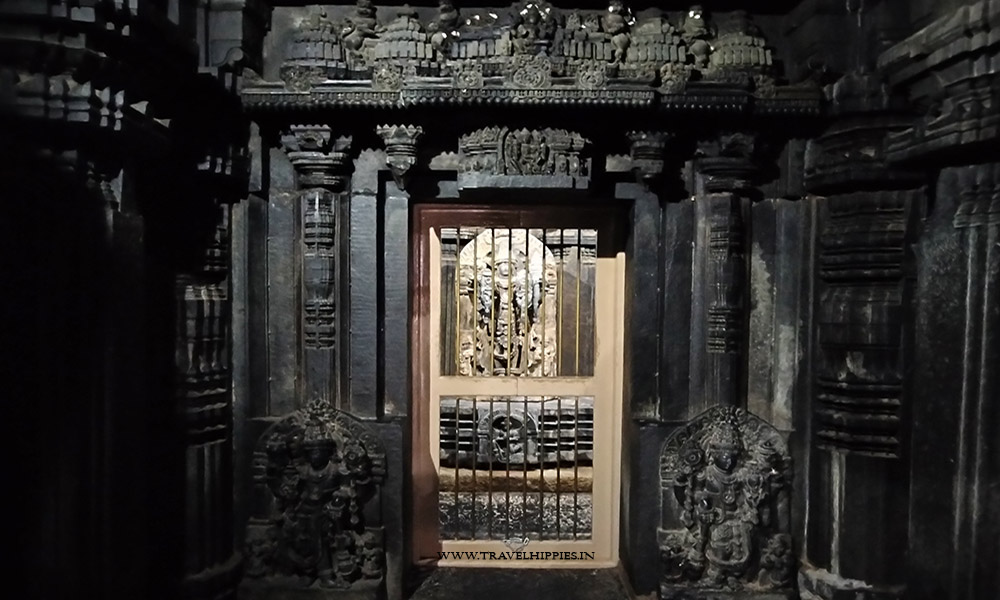
The entrance has the figures of Yoganarayana, Gajalakshmi and a Vishnu reclining on Shesha Nag (Snake).
Venugopala
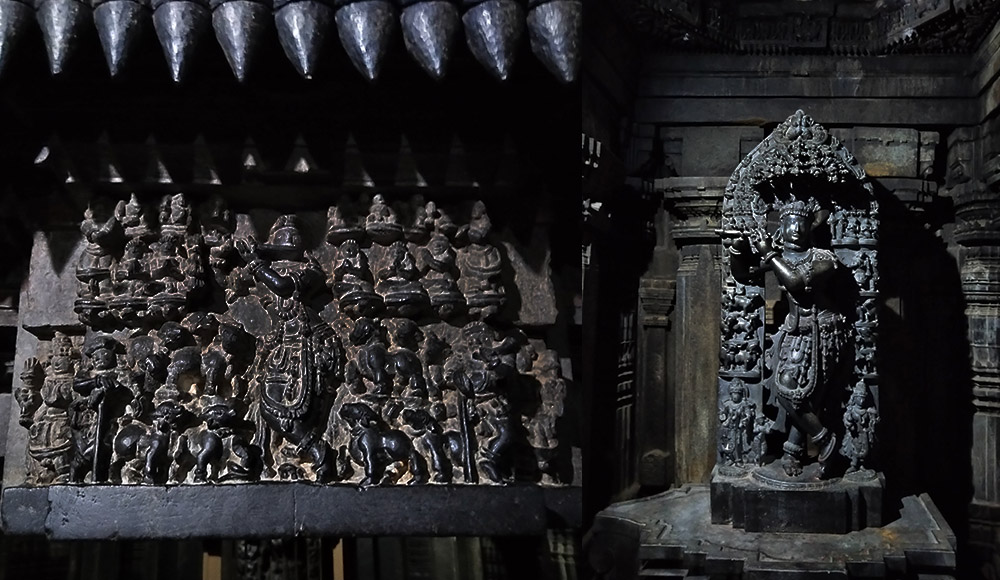
The shrine faces the southern direction and is extensively elaborated to make it look a lively scene where Krishna is playing the flute. On observing it closely, you would realize that an opulently clad Krishna’s fingers are all busy playing the flute. The gods, devatas from the Swarga Loka, sages, people from Vrindavan-Mathura and even the cows are engrossed in the hypnotic music played by Venugopala. Even his wives Rukmani and Satyabhama can also be seen. Such vivid engraving of scenery to make it look lifelike is really an excellent skill projected by the sculptor.
The same scenery can be seen in a miniature form on the Torana of this garbhgriha. The dwarpalaks Jaya and Vijaya can also be seen guarding the gate. In addition to this, the ten avatars of Vishnu and a dancing Vishnu can also be seen on the garbhgriha entrance.
Janadarna

The common thing between the south and the north shrine is the carved figure of Yoganarayan, a seated Vishnu in Yogik pose and Dwarpal Jaya and Vijaya. Here, the four-handed Janardana can be seen holding Shankh, Chakra, Gada and Padma. In this shrine too, the miniature of the actual idol has been placed on the toran of the entrance. You can even observe the nails of the deity Janadarna that tells of the minute details considered by the sculptor.
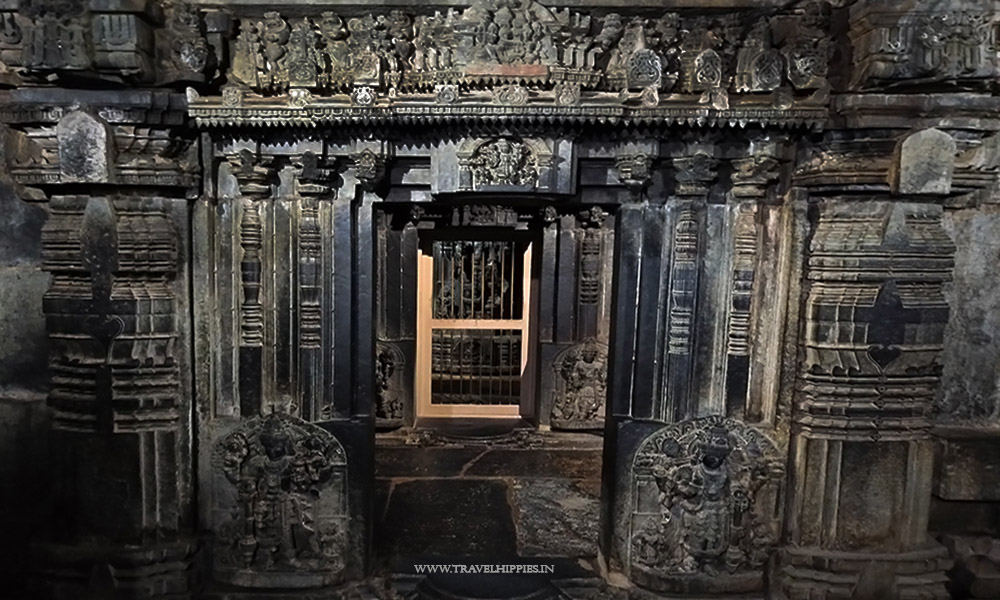
Have more questions? Write in the comment and I will be more than happy to answer.
Pin it now, Refer it Later.
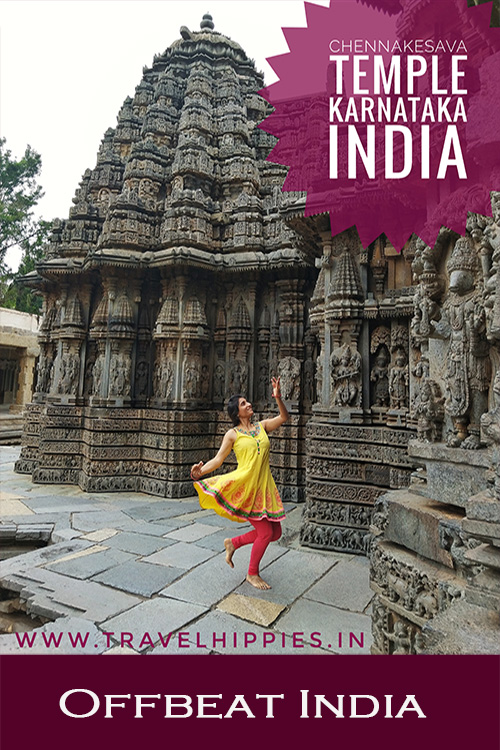
Follow me on

This is an extremely extraordinary write up with photos. It’s unbeatable. Deep thanks. It was useful to no end.